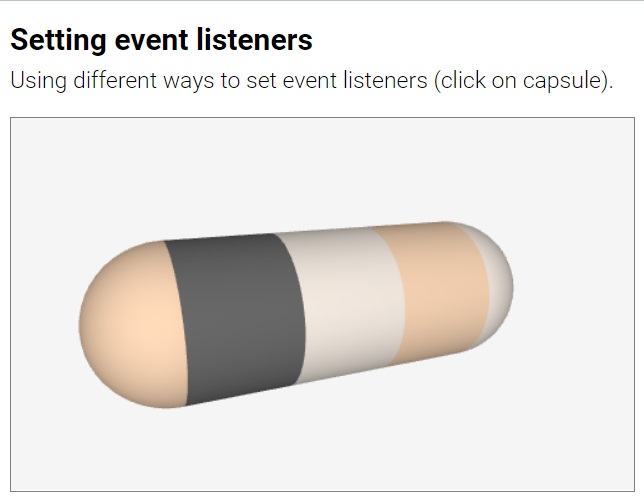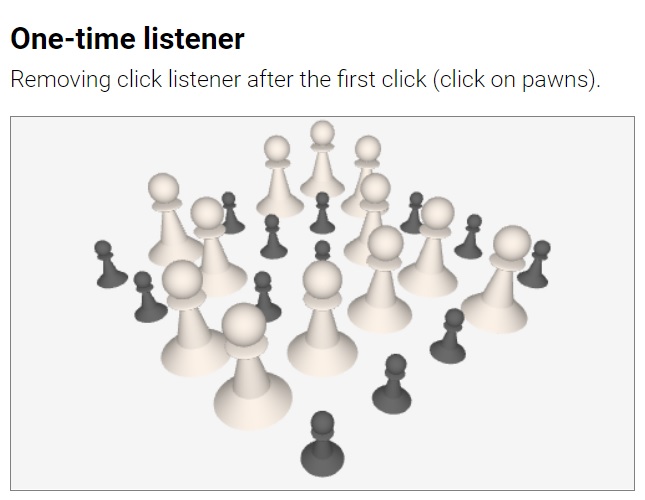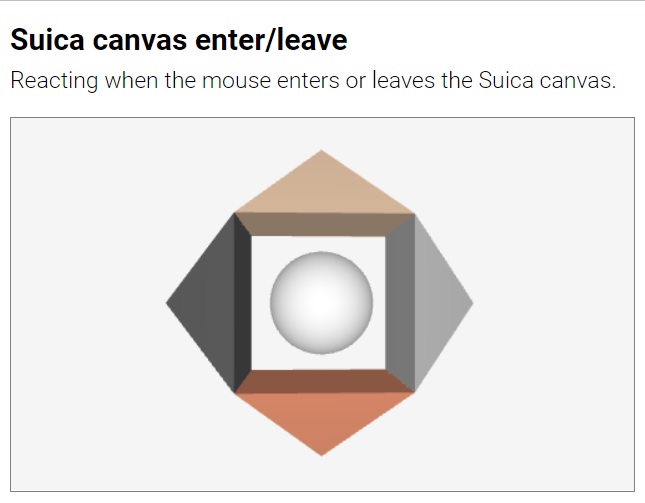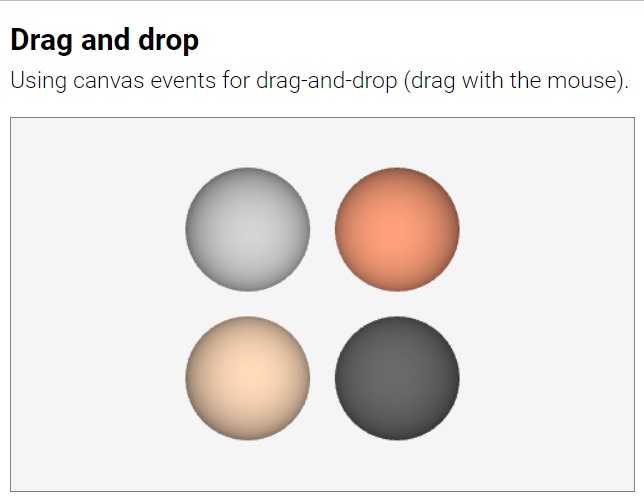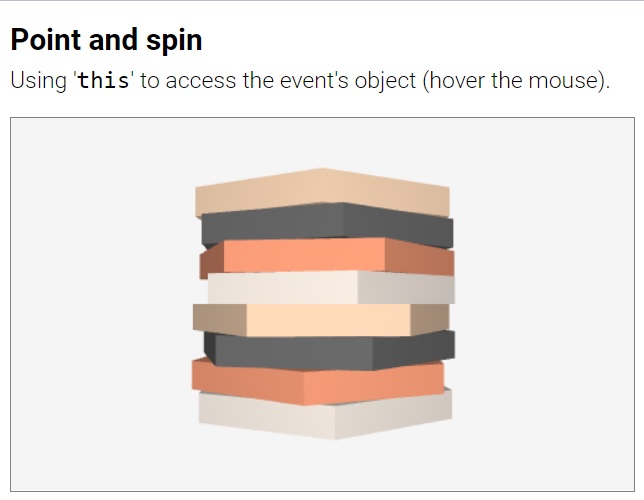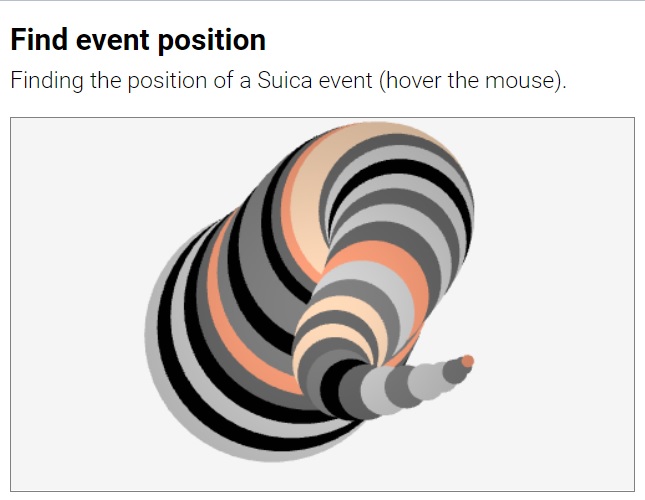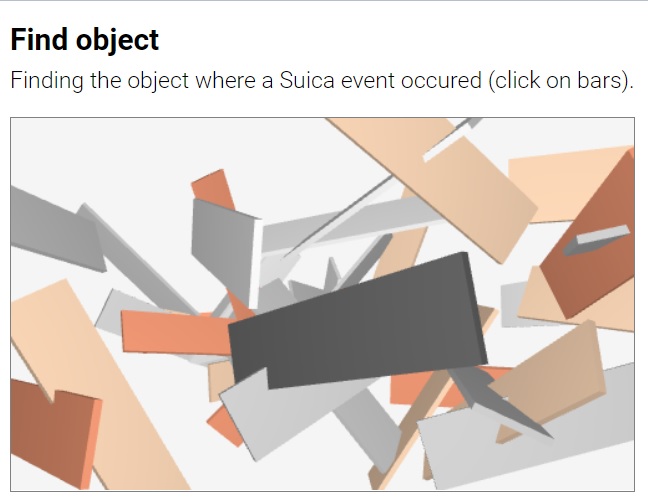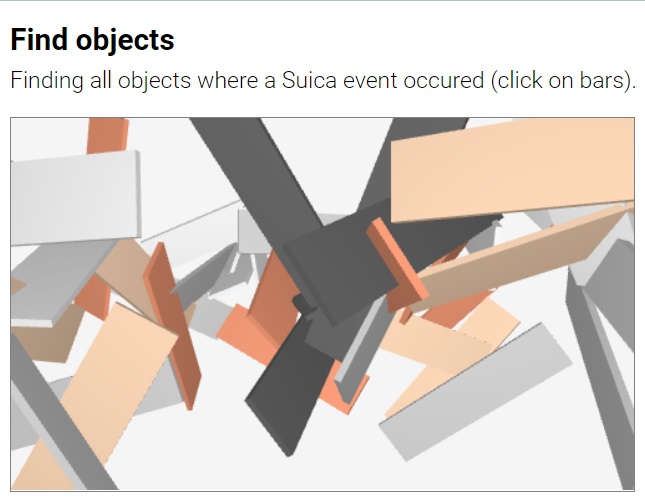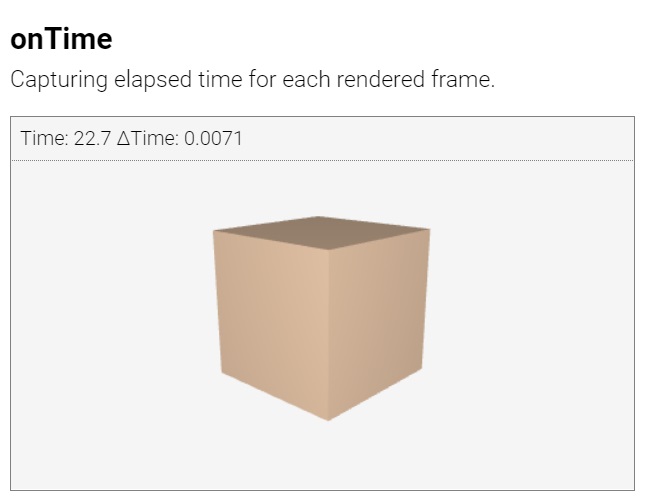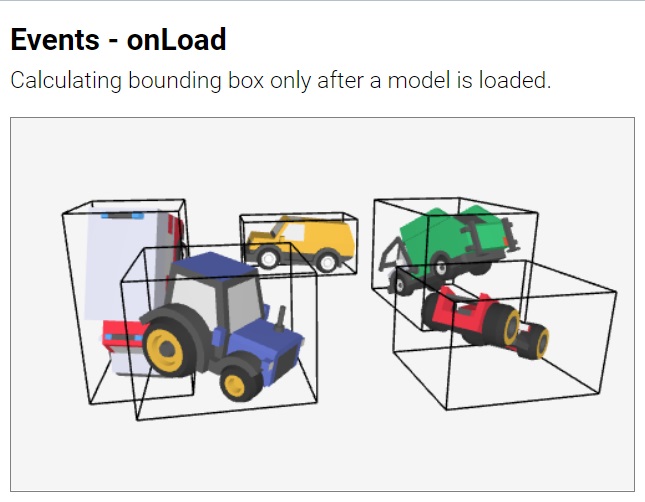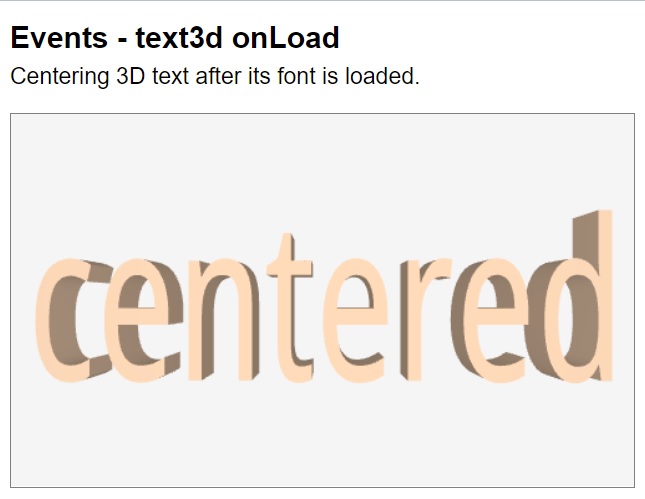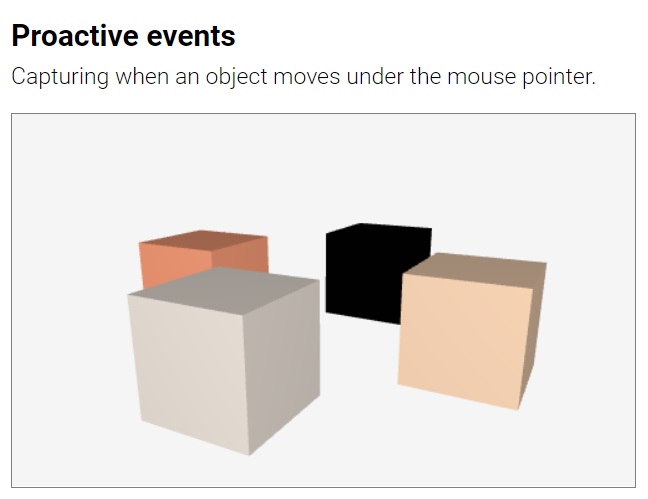Suica events are actions that happen ‘outside’ a Suica program and it is impossible to predict when they will happen. A typical example of an event is when users click, tap or touch Suica objects.
Table of contents
- Introduction
- Motion events:
onPointerEnter,onPointerMove,onPointerLeave - Click events:
onPointerDown,onPointerUp,onClick - Time events:
onTime - Load events:
onLoad
- Motion events:
- Working with events
Introduction
Suica supports a simplified model of events. It is similar to the traditional web page events, but are tuned for Suica objects. Suica supports motion events, click events and time events.
Motion events
Motion events are onPointerEnter, onPointerMove and onPointerLeave. They occur when the pointer (mouse, stilus or finger) enters, moves over or leaves Suica canvas or Suica object.

Click events
Click events are onPointerDown, onPointerUp and onClick. They occur when a pointer or its button is pressed, released or clicked over Suica canvas or Suica object.

Time events
Time event is onTime. It occurs when the browser is ready for a new frame.
Load events
Load event is onLoad. It occurs when a data resource is loaded.
Working with events
An event is managed by two elements:
- Event listener: An HTML or JavaScript declaration that an object is interested in a specific event
- Event handler: A JavaScript user-defined function that is activated when an event occurs
Events that are not listened to, are ignored.
Event listeners
In Suica event listeners can be set for Suica canvas and for individual Suica objects. For example, a canvas onClick event occurs when the user clicks anywhere in the canvas, while an object onClick event occurs when the user clicks on the image of the object. Similarly, a canvas onPointerEnter occurs when the pointer enters the canvas, while an object onPointerEnter occurs when the pointer enters the boundary of the object’s image.
In HTML event listeners are set as attributes.
HTML:
<object eventName="eventHandler">
The name of the attribute is the name of the event, which is case-insensitive and it can be with or without on- prefix. The value of the attribute is the name of the event handler function. The following code snippets install listeners of pointer click events to the whole Suica canvas and to a cube.
HTML:
<suica click="clickOnCanvas">
<cube onClick="clickOnObject">
In JavaScript event listeners are set by addEventListener and removed by removeEventListener.
addEventListener
JS:
object.addEventListener( eventName, eventHandler );
Function. Adds an event listener to specific eventName that triggers an eventHandler function. eventName is the case-insensitive name of the event with or without on- prefix, thus pointerMove and onPointerMove are considered the same event. Only one event handler per event per object can be set, i.e. setting another event handler will replace the previous one. Suica’s addEventListener mimics to some extent the DOM’s addEventListener which is used to set event listeners for HTML elements in a web page.
JS:
suica.addEventListener( 'pointerMove', eventHandler );
obj.addEventListener( 'onPointerMove', eventHandler );
In JavaScript an event listener can be set directly, but the event name must be on- prefixed and lowercased.
JS:
// click, Click and onClick will not work
obj.onclick = eventHandler;
removeEventListener
JS:
object.removeEventListener( eventName );
Function. Removes an event listener of specific eventName. eventName is the case-insensitive name of the event with or without on- prefix, thus pointerMove and onPointerMove are considered the same event. removeEventListener
mimics to some extent the DOM’s
removeEventListener which is used to remove event listeners for HTML elements in a web page.
JS:
suica.removeEventListener( 'pointerMove' );
obj.removeEventListener( 'onPointerMove' );
In JavaScript an event listener can be removed directly by assigning a null value, but the event name must be on- prefixed and lowercased.
JS:
// click, Click and onClick will not work
obj.onclick = null;
Pointer event handlers
In Suica event handlers are defined only in JavaScript and they are functions that are activated from listeners when a specific event occurs. Often the name of the event handler is the same as the name of the corresponding event, although this is not enforced. These functions have optional, but predefined parameters.
All pointer-related events, these are onPointerEnter, onPointerMove, onPointerLeave, onPointerDown, onPointerUp and onClick, provide parameter event to their handlers.
JS:
function eventHandler( event )
{
...
}
The actual name of the parameter is user-defined, but traditionally ‘event’ is used. The following snippet illustrates the definition of a event handler for onPointerEnter event. Note that both the function name and the parameter name are user-defined.
JS:
function onPointerEnter( event )
{
...
}
The event parameter describes the event and its structure is the same as DOM’s PointerEvent. The parameter contains data about event time and place, mouse buttons, pressed keys, stilus tilt, finger pressure etc. These data can be used to implement drag-and-drop operations. Each event handler is run from within the object that reacted to the event. The system variable this in the event handler points to this object. This is used to identify the object when several objects share the same event handler.
JS:
function onPointerMove( event )
{
if( event.ctrlKey )
{
this.center = [0,0,0];
this.color = 'crimson';
}
}
Additional Suica-specific data for pointer events is extracted from event by
findPosition, findObject and findObjects.
findPosition
JS:
pos = findPosition( event );
Function. Finds the position of a pointer event. The position is measured in pixels and is relative to the center of the Suica canvas. The function requires the event parameter of the event handler. The result is an array [x,y] of the position. findPosition is typically used with events of the Suica canvas.
JS:
function onPointerMove( event )
{
var pos = findPosition( event );
}
The returned position coincides with the Suica coordinate system when orthographic camera is used and the view point is not changed with demo or lookAt.

findObject
JS:
object = suica.findObject( event, interactive );
object = suica.findObject( event, [object, object, ...] );
Function. Finds the Suica object where a pointer event occurred. The function requires the event parameter of the event handler. The result is the closest to the viewer Suica object that is at the position of the event, or null if no such object exists. findObject is typically used with events of the Suica canvas. If interactive is true then only objects with event handlers for motion and click events are scanned. By default interactive is false. If the value of interactive is an array of objects, then only these objects are scanned.
JS:
function onPointerMove( event )
{
var object = findObject( event );
}
If an object is found its intersectData property is also set.
findObjects
JS:
object = suica.findObjects( event, interactive );
object = suica.findObjects( event, [object, object, ...] );
Function. Finds all Suica objects where a pointer event occured. The function requires the event parameter of the event handler. The result is a sorted list (from nearest to farthest with respect to the viewer) of all Suica objects that are at the position of the event, or an empty list [] if no such objects exist. findObjects is typically used with events of the Suica canvas. If interactive is true then only objects with event handlers for motion and click events are scanned. By default interactive is false. If the value of interactive is an array of objects, then only these objects are scanned.
JS:
function onPointerMove( event )
{
var object = findObjects( event );
}
If objects are found their intersectData properties are also set.
Time event handlers
The time event onTime occurs when the browser is ready for a new frame. The browser tries to generate the event at regular time intervals, usually 60 or 30 times per second, but this is not guaranteed. The time event provides two parameters t and dT – elapsed times since the start of Suica and since the previous frame. Both are measured in seconds, thus 2.3 means 2.3 seconds (2 seconds and 300 milliseconds).
JS:
function onTime( t, dT )
{
...
}
Load event handlers
The load event onLoad occurs when a 3D model or the font of a text3d is loaded. The load event provides parameter object that is the object being loaded. This parameter is used when a load event handler is shared across several objects.
JS:
function onLoad( object )
{
...
}
The first example calculates the bounding boxes of 3D models. This uses the vertices property that is available only when a model is completely loaded. The second example centers the 3D text after its font is loaded.
Proactive events
Suica supports proactive mode for pointer motion events onPointerEnter, onPointerMove and onPointerLeave. This mode can be turned on with HTML attribute, HTML tag or JavaScript command.
proactive
HTML:
<suica proactive>
<proactive>
JS:
proactive( );
Command. Turns on proactive mode. Normal pointer motion events only occur when the pointer is moved into, over or out of an object. In proactive mode these events are triggered even when the pointer is stationary, but an object moves into, under or out of the pointer.
Proactive mode is resource consuming. For every frame all objects in Suica are tested against the pointer position. When a proactive event occurs Suica executes the assigned event handler and passes the latest pointer event structure as a parameter to the handler.
